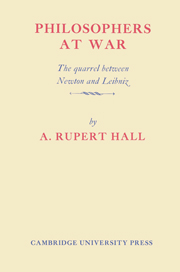Book contents
- Frontmatter
- Contents
- Preface
- Chronological Outline
- 1 Introduction
- 2 Beginnings in Cambridge
- 3 Newton states his claim: 1685
- 4 Leibniz encounters Newton: 1672–1676
- 5 The emergence of the calculus: 1677–1699
- 6 The outbreak: 1693–1700
- 7 Open warfare: 1700–1710
- 8 The philosophical debate
- 9 Thrust and parry: 1710–1713
- 10 The dogs of war: 1713–1715
- 11 War beyond death: 1715–1722
- Appendix: Newton's “Account of the Book entituled Commercium Epistolicum”
- Notes
- Index
4 - Leibniz encounters Newton: 1672–1676
Published online by Cambridge University Press: 16 October 2009
- Frontmatter
- Contents
- Preface
- Chronological Outline
- 1 Introduction
- 2 Beginnings in Cambridge
- 3 Newton states his claim: 1685
- 4 Leibniz encounters Newton: 1672–1676
- 5 The emergence of the calculus: 1677–1699
- 6 The outbreak: 1693–1700
- 7 Open warfare: 1700–1710
- 8 The philosophical debate
- 9 Thrust and parry: 1710–1713
- 10 The dogs of war: 1713–1715
- 11 War beyond death: 1715–1722
- Appendix: Newton's “Account of the Book entituled Commercium Epistolicum”
- Notes
- Index
Summary
If it takes two to make a quarrel, it takes two men of genius to make a famous quarrel. If Newton is one of the half-dozen mightiest figures in the history of science, Gottfried Wilhelm Leibniz enjoys an equal eminence in the history of philosophy. And though in the folk culture of the Germans Leibniz may stand as a lesser man than Goethe, just as in Anglo-Saxon eyes Newton must bow to Shakespeare, by more formal standards each appears as the dominant figure of an aspect of European intellectual life. It is perhaps not accidental that they were contemporaries, Newton's life-span exceeding Leibniz's by a few years at either end, for this was the moment when European intellectual development toward freedom and maturity offered the highest opportunity for creativity. This was the point of flexure on its growth curve. Of course, both Newton and Leibniz were men of transition, thinking for the future with minds conditioned by the past. It might be imagined, perhaps, that Newton the scientist, the man of numbers rather than words, belonged more decisively to the new age than did Leibniz, of whom it has been written that “he is, in relation to the new scientists [of the seventeenth century], a man sunk deep in medieval conceptions, a weaver of metaphysical systems, a believer in the necessary unity of theology, philosophy and science.”
- Type
- Chapter
- Information
- Philosophers at WarThe Quarrel between Newton and Leibniz, pp. 44 - 69Publisher: Cambridge University PressPrint publication year: 1980



